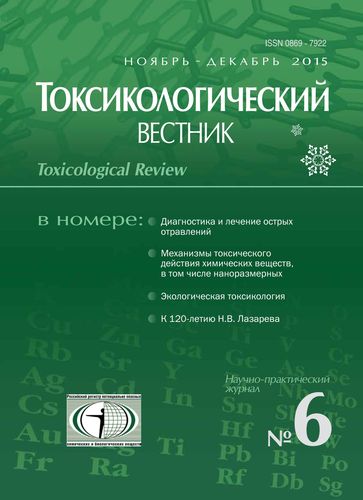CYTOPATHOLOGY OF PERIPHERAL BLOOD ERYTHROCYTES AND POLYMORPHISM OF GLUTATIONE-S-TRANSFERASE GENES IN WORKERS OF MERCURY PRODUCING AND RECYCLING INDUSTRY
- Authors: Ilyinskikh N.N.1,2, Ilyinskikh E.N.1,3, Ilyinskikh I.N.1, Gvozdareva O.V.1
-
Affiliations:
- State Budgetary Educational Institution of Higher Professional Education «Siberian State Medical University» of the Ministry of Healthcare of the Russian Federation
- Federal State Autonomous Educational Institution of Higher Education «National Research Tomsk State University» of the Ministry of Education and Science of the Russian Federation
- Federal State Autonomous Educational Institution of Higher Education «National Research Tomsk Polytechnic University» of the Ministry of Education and Science of the Russian Federation
- Issue: No 6 (2015)
- Pages: 17-21
- Section: Articles
- Published: 04.12.2015
- URL: https://rjsocmed.com/0869-7922/article/view/641355
- DOI: https://doi.org/10.15690/vramn520
- ID: 641355
Cite item
Full Text
Abstract
The aim of this study was to evaluate the association between glutathione-S-transferase (GST) genes polymorphism and the frequency of cytopathology of peripheral blood erythrocytes in the workers occupationally exposed to mercury as well as in the occupationally non-exposed local population of the Aktash settlement of the Republic Altai (control group). It was found that the workers of the mercury producing and recycling enterprise with deletion (null)-variant GSTM1 genes showed significantly higher levels of anisocytosis in the peripheral blood than both the GSTM1 positive individuals and the control group (P<0,01). In addition, the null variants of both GSTM1 and GSTT1 genes in workers were significantly associated with the elevated frequency of poikilocytosis, particularly macrocytosis, and micronucleated erythrocytes in the peripheral blood as compared to the controls and the active genotype GSTM1(+) / GSTT1(+) (P<0,01). Moreover, the increased level of microcytosis was detected exclusively in workers with the combination of null variants of GSTT1(o) and GSTM1(o) genes. Analysis of the data of the control group as well as the workers exposed to mercury, demonstrated that in the individuals with the combination of null variants of GSTT1 and GSTM1 genes, the frequency of micronucleated erythrocytes was significantly higher than in the ones with active genotypes of GSTM1(+) / GSTT1(+).
About the authors
Nikolai Nikolaevich Ilyinskikh
State Budgetary Educational Institution of Higher Professional Education «Siberian State Medical University» of the Ministry of Healthcare of the Russian Federation;Federal State Autonomous Educational Institution of Higher Education «National Research Tomsk State University» of the Ministry of Education and Science of the Russian Federation
Author for correspondence.
Email: noemail@neicon.ru
Заведующий кафедрой биологии и генетики, доктор биологических наук ГБОУ ВПО СибГМУ профессор кафедры экологии и экологического менеджмента, ФГАОУВО НИТГУ, 634050, г. Томск, Российская Федерация
e-mail: nauka-tomsk@yandex.ru
Russian FederationEkaterina Nikolaevna Ilyinskikh
State Budgetary Educational Institution of Higher Professional Education «Siberian State Medical University» of the Ministry of Healthcare of the Russian Federation;Federal State Autonomous Educational Institution of Higher Education «National Research Tomsk Polytechnic University» of the Ministry of Education and Science of the Russian Federation
Email: noemail@neicon.ru
Профессор кафедры инфекционных болезней и эпидемиологии, доктор медицинских наук ГБОУ ВПО СибГМУ, профессор кафедры геохимии и геоэкологии ФГАОУВО НИТПУ, 634050, г. Томск, Российская Федерация
e-mail: ilyinskikh@yandex.ru
Russian FederationIrina Nikolaevna Ilyinskikh
State Budgetary Educational Institution of Higher Professional Education «Siberian State Medical University» of the Ministry of Healthcare of the Russian Federation
Email: noemail@neicon.ru
Профессор кафедры микробиологии и вирусологии, доктор биологических наук ГБОУ ВПО СибГМУ, 634050, г. Томск, Российская Федерация
e-mail: ilyinskikh@yandex.ru
Russian FederationOlga Vladimirovna Gvozdareva
State Budgetary Educational Institution of Higher Professional Education «Siberian State Medical University» of the Ministry of Healthcare of the Russian Federation
Email: noemail@neicon.ru
Аспирант ГБОУ ВПО СибГМУ, 634050, г. Томск, Российская Федерация
e-mail: sbornik-tomsk@mail.ru
Russian FederationReferences
- Robertus Ju.V., Puzanov A.V., Ljubimov R.V., Arhipov I.A. Ecogeochemistry of mercury in the environment and technogenetics objects near the Aktash mining and smelting enterprise.// Mir nauki, kul’tury, obrazovanua. 2010; (2):280-2 (in Russian).
- Crespo-Lopez M.E., Macedo G.L., Arrifano G.P., Pinheiro Mda C., do Nascimento J.L., Herculano A.M. Genotoxicity of mercury: contributing for the analysis of Amazonian populations. //Environ. Int. 2011; 37(1):136-41.
- Soto-Rfos M.L., Rothenberg S., Gonsebatt M.E., Talavera-Mendoza O. Cytogenotoxicity in uroepithelial cells of women exposed to mercury in a mining area.// Occup. Environ. Med. 2010; 67(9):620-4.
- Gundacker C., Komarnicki G., Jagiello P., Gencikova A., Dahmen N., Wittmann K.J. et al. Glutathione-S-transferase polymorphism, metallothionein expression, and mercury levels among students in Austria.// Sci. Total. Environ. 2007; 385(1-3):37-47
- Abdel-Rahman S.Z., el-Zein R.A., Anwar W.A., Au W.W. A multiplex PCR procedure for polymorphic analysis of GSTM1 and GSTT1 genes in population studies. // Cancer. Lett. 1996; 107(2): 229-33.
- Walker H.K., Hall W.D., Hurst J.W., eds. Clinical Methods: The History, Physical, and Laboratory Examinations. 3rd ed. Boston: Butterworths; 1990.
- Ilyinskikh N.N., Ksenc A.S., Ilyinskikh E.N. Micronuclei analysis in the assessment of cytogenetic instability. Tomsk: TGPU; 2011 (in Russian).
- Borovikov V.P., Borovikov I.P. Statistic analysis and the data processing in the environment of «Windows». M: Filin; 1997 (in Russian).
- Ochi T. Methylmercury, but not inorganic mercury, causes abnormality of centrosome integrity (multiple foci of gamma-tubulin), multipolar spindles and multinucleated cells without microtubule disruption in cultured Chinese hamster V79 cells.// Toxicology. 2002; 175(1-3):111-21.
- Bonacker D., Stoiber T., Wang M., Bohm K.J., Prots I., Unger E. et al. Genotoxicity of inorganic mercury salts based on disturbed microtubule function. Arch Toxicol. 2004; 78(10):575-83.
- Lee B.-E., Hong Y.-C., Park H., Ha M., Koo B.S., Chang N. et al. Interaction between GSTM1/GSTT1 Polymorphism and Blood Mercury on Birth Weight. // Environmental Health Perspectives. 2010; 118(3):437-43.
Supplementary files









